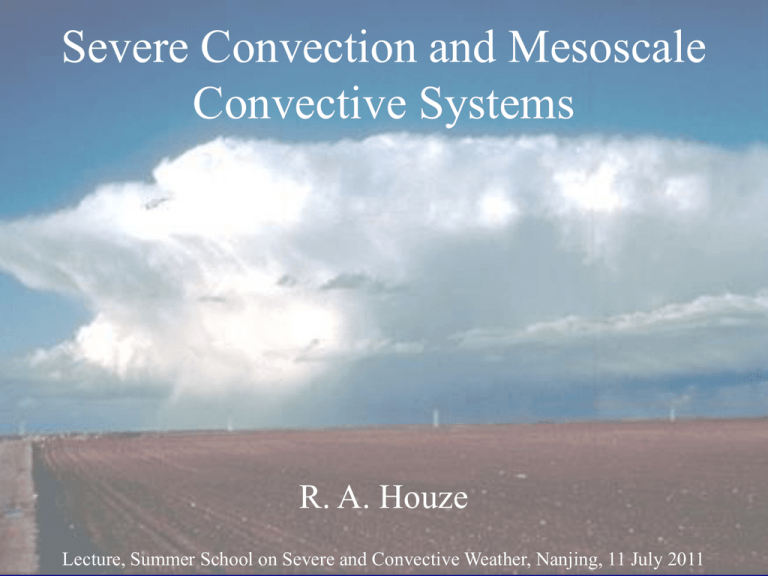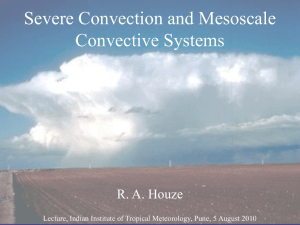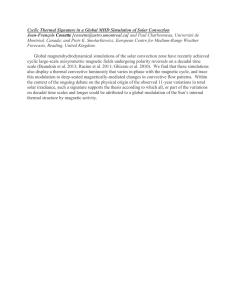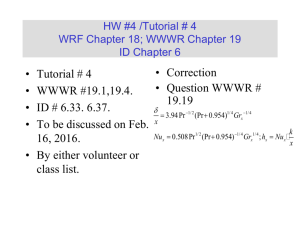Severe Convection and Mesoscale Convective Systems R. A. Houze
advertisement

Severe Convection and Mesoscale Convective Systems R. A. Houze Lecture, Summer School on Severe and Convective Weather, Nanjing, 11 July 2011 Convective Clouds Lecture Sequence 1. 2. 3. 4. 5. 6. 7. Basic convective cloud types Severe convection & mesoscale systems Tropical cloud population Convective feedbacks to large-scales Extreme convection Diurnal variability Clouds in tropical cyclones Two Types of Cumulonimbus “Multicell Thunderstorm” “Supercell Thunderstorm” Why are there two types of cumulonimbus? What determines p’ ? Recall pressure perturbation is determined by In single-cell and multi-cell thunderstorms negligible Strong rotation in cloud produces cyclostrophic pressure minima in the cloud dynamic forcing becomes important! This changes the storm from multicell to supercell Tilting of the environment shear & “storm splitting” Assume unidirectional shear min p’ tilting of environment vorticity vortex min p’ PG force Storm “splits” as a result of this rotationdetermined vertical force End up with two storms! Klemp 1987 Nonlinear processes required to form the mesocyclone Based on Rotunno 1981 Why don’t we get two storms? Directional shear The effect of directional shear can be seen by linearizing ( Ñ2 p*D = FD = -Ñ × ro v × Ñv About a mean velocity of ( v = u,v ,0 ) Which leads to Where S is the environment shear ) Middle level of storm S This implies lifting at low levels on downshear side of storm. When the hodograph is “unidirectional” Unidirectional shear In addition to pressure forces that cause storm splitting, vertical pressure gradient forces updraft on downshear side of storm, so storm BOTH splits AND moves forward. PG force Klemp 1987 When the hodograph is “clockwise” Vertical pressure VPG gradient forces updraft on the right flank; downdraft on left flank. Clockwise hodograph Right-mover favored Klemp 1987 Probable Location of Tornadic Thunderstorms Tornado environment sounding CU PU “cap” T CU Tornado (T) forms where wind pattern creates strong combination of CU and PU Probable Location of Tornadic Thunderstorms Tornado environment hodograph Note some shear is in the boundary layer T Tornado (T) forms where the shear is both strong & directional Tornadogenesis Further considerations for tornadic storms: •Shear in boundary layer (“helicity”) •Generation of vorticity by the storm Factors contributing to tornado formation MESOCYCLONE HELICITY HORIZONTAL VORTICITY GENERATION Mesoscale Convective System ~500 km Mesoscale Convective System Three MCSs Radar Echoes in the 3 MCSs 1458GMT 13 May 2004 Stratiform Precipitation Convective Precipitation When convection organizes into a mesoscale convective system •parcel theory doesn’t apply •layer lifting occurs Parcel Model of Convection Parcels of air arise from boundary layer This doesn’t apply to mature MCS Layer Lifting Gravity Wave Interpretation Mean heating in convective line Horizontal wind Mesoscale response to the heating in the line 0 Pandya & Durran 1996 Vorticity interpretation When an MCS forms in a sheared environment, solutions to 2D vorticity equation look like this: B>0 Shear Moncrieff 1992 Vorticity interpretation Model results are consistent with the theory Horizontal vorticity generated by the line of convection B>0 Get updraft in the form of a deep layer of ascending front-to-rear flow Fovell & Ogura 1988 Subdivision of precipitation of MCS into convective and stratiform components Old convection Vigorous convection 100 km Houze 1997 Vigorous Convection Max w > (VT)snow Height Big particles fall out near updraft Get vertical cores of max reflectivity Distance Houze 1997 Old Convection Heigh t (VT)snow~1-2 m/s Ice particles drift downward Melting produces “bright band” Distance Houze 1997 Height How convective cells distribute precipitation particles in the MCS “Particle fountains” Yuter & Houze 1995 Generalized structure of an MCS in shear This type of MCS propagates with a •leading line of convection, aided by downdraft cold pool, and •trailing stratiform precipitation Storm motion Sheared flow leads to older convective elements being advected rearward SF precipitation area is to the rear. Houze et al. 1989 Heating & Cooling Processes in an MCS SW Cloud Cpndensation and Deposition LW This vertical distribution of diabatic processes applies whether the MCS is propagating or not Melting LW Evaporation 125 km 30 km Stratiform Convective precipitation precipitation Houze 1982 Simplified MCS Heating Profiles Height (km) Stratiform Convective Schumacher et al. 2004 Deg K/day Conclusion of Lectures 1 & 2: We have looked at all but the TCs Cumulonimbus Cumulus Mesoscale Convective System Stratocumulus Later ✔ Stratus Tropical Cyclone Summary of key points Stratocumulus • • • • Turbulence Entrainment Radiation Drizzle Cumulus & Cumulonimbus •Buoyancy •Entrainment •Anvil cloud & thunderstorms •Intensity over land & ocean •Pressure perturbations •Vorticity Intense Cumulonimbus • Rotation • Speed and directional shear Mesoscale Convective Systems •Layer lifting •Convective vs stratiform precipitation •Heating profiles Convective Clouds Lecture Sequence 1. 2. 3. 4. 5. 6. 7. Basic convective cloud types Severe convection & mesoscale systems Next Tropical cloud population Convective feedbacks to large-scales Extreme convection Diurnal variability Clouds in tropical cyclones End This research was supported by NASA grants NNX07AD59G, NNX07AQ89G, NNX09AM73G, NNX10AH70G, NNX10AM28G, NSF grants, ATM-0743180, ATM-0820586, DOE grant DE-SC0001164 / ER-6 Flight Level Temperature (deg C) Precipitation-sized Ice Particles in MCSs over the Bay of Bengal in MONEX -25 -20 Columns Columns Plates & Dendrites Aggregates & Drops Dendrites -15 -10 -5 0 Needles * * Melting Relative Frequency of Occurrence Houze & Churchill 1987 Development of stratiform precipitation in a mesoscale convective system Supercell Storm Hail Rain


